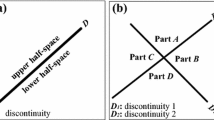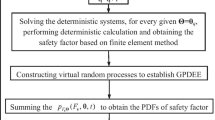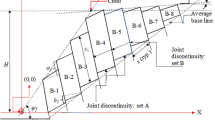Abstract
Wedge failures are frequently observed in rock slopes. However, these conventional probability analysis methods for rock wedge stability analysis suffer from a known critic of poor efficiency and accuracy. This paper proposes two analytical probabilistic methods (JDRV method and SAPM) to address these issues. The proposed methods are illustrated through a practical rock wedge example. By the comparison with the Monte Carlo simulation (MCs), it can be concluded that the JDRV method is reliable and accurate for the random variables with normal and lognormal distribution, but SAPM is only reliable and accurate for those with normal distribution. The results of the JDRV method and SAPM also indicate that the failure probability of rock wedge will decrease for the random variables with normal distribution with the reduction of correlation coefficient, while the failure probability will increase for the random variables with lognormal distribution. Moreover, the failure probability of rock wedge with biplane sliding mode can greatly be reduced by improving the strength of the discontinuity plane whose effective normal load or area is larger in the two discontinuity planes.









Similar content being viewed by others
Abbreviations
- c :
-
Cohesion of discontinuity plane
- φ :
-
Friction angle of discontinuity plane
- H :
-
Height of rock slope and slope angle
- α :
-
Slope angle
- δ :
-
Dip angle of top slope surface
- A, B:
-
Discontinuity planes
- β :
-
Dip angles of the intersection line
- G :
-
Weight of rock
- A :
-
Area of discontinuity plane
- N :
-
Effective normal load acting on discontinuity plane
- θ :
-
Angle between effective normal load and sliding force
- F s :
-
Factor of safety
- μ c :
-
Mean of cohesion
- σ c :
-
Standard deviation of cohesion
- μ φ :
-
Mean of friction angle
- σ tan φ :
-
Standard deviation of random variable tanφ
- r :
-
Correlation coefficient
- μ c `, σ c ` :
-
Mean of converted cohesion, respectively
- μ φ `, σ φ ` :
-
Standard deviation of converted friction angle, respectively
- f X(x):
-
Probability density function of random variable X
- f Y(y):
-
Probability density function of random variable Y
- f X+Y(z):
-
Probability density function of random variable X + Y
- k :
-
Random variable
- P f :
-
Failure probability
- f FOS(FOS):
-
Probability density function of the factor of safety
- FOS 0 :
-
Minimal value of the factor of safety
- μ Fs :
-
Mean of the factor of safety
- σ Fs :
-
Standard deviation of the factor of safety
- ∆F s :
-
Perturbations of the factor of safety
- ∆c 1 :
-
Perturbations of c1
- ∆c 2 :
-
Perturbations of c2
- ∆tan φ 1 :
-
Perturbations of tan φ1
- ∆tan φ 2 :
-
Perturbations of tan φ2
- ∆lnF s :
-
Perturbations of lnFs
- ∆lnc 1 :
-
Perturbations of lnc1
- ∆lnc 2 :
-
Perturbations of lnc2
- ∆lntan φ 1 :
-
Perturbations of lntan φ1
- ∆lntan φ 2 :
-
Perturbations of lntan φ
- Φ[·]:
-
Cumulative standard normal distribution function
- COV Pf :
-
Variation coefficient of failure probability
- JDRV:
-
Jointly distributed random variables (JDRV)
- SAPM:
-
Simple analytical probabilistic method
- MCs:
-
Monte carlo simulation
References
Hoek E, Bray JD (1981) Rock slope engineering. The institute of mining and metallurgy, London
Jiang QH, Liu XH, Wei W, Zhou CB (2013) A new method for analyzing the stability of rock wedges. Int J Rock Mech Min Sci 60:413–422. https://doi.org/10.1016/j.ijrmms.2013.01.008
Lucas JM (1980) A general stereographic method for determining the possible mode of failure of any tetrahedral rock wedge. Int J Rock Mech Min Sci Geomech Abstr 17(1):57–61. https://doi.org/10.1016/0148-9062(80)90006-6
Nathanail CP (1996) Kinematic analysis of active/passive wedge failure using stereographic projection. Int J Rock Mech Min Sci Geomech Abstr 33(4):405–407. https://doi.org/10.1016/0148-9062(95)00079-8
Goodman RE (1989) Introduction to rock mechanics, New York.
Chen ZY (1999) The limit analysis for slopes: theory, methods and applications, In: Proceedings of the international symposium on slope stability engineering. Rotterdam: Balema, pp. 15–29.
Chen ZY (2004) A generalized solution for tetrahedral rock wedge stability analysis. Int J Rock Mech Min Sci 41(4):613–628. https://doi.org/10.1016/j.ijrmms.2003.12.150
Zhou JF, Wang JX (2017) Lower bound limit analysis of wedge stability using block element method”. Comput Geotech 86:120–128. https://doi.org/10.1016/j.compgeo.2016.12.031
Wang YJ, Yin JH, Chen Z, Lee CF (2004) Analysis of wedge stability using different methods. Rock Mech Rock Eng 37(2):127–150. https://doi.org/10.1007/s00603-003-0023-y
Jiang QH, Qi ZF, Wei W, Zhou CB (2015) Stability assessment of a high rock slope by strength reduction finite element method. Bull Eng Geol Env 74(4):1153–1162. https://doi.org/10.1007/s10064-014-0698-1
Stead D, Eberhardt E, Coggan JS (2006) Developments in the characterization of complex rock slope deformation and failure using numerical modelling techniques. Eng Geol 83(1–3):217–235. https://doi.org/10.1016/j.enggeo.2005.06.033
Son M, Adedokun S (2015) Comparison of earth pressure between numerical and analytical methods for jointed rock wedges. KSCE J Civ Eng 19(7):2075–2082. https://doi.org/10.1007/s12205-015-0318-z
Weng MC, Lo CM, Wu CH, Chuang TF (2015) Gravitational deformation mechanisms of slate slopes revealed by model tests and discrete element analysis. Eng Geol 189:116–132. https://doi.org/10.1016/j.enggeo.2015.01.024
Baecher GB, Christian JT (2005) Reliability and statistics in geotechnical engineering. John Wiley & Sons, West Sussex
Tatone BSA, Grasselli G (2010) ROCKTOPPLE: a spreadsheet-based program for probabilistic block-toppling analysis. Comput Geosci 36(1):98–114. https://doi.org/10.1016/j.cageo.2009.04.014
Low BK, Einstein HH (1992). Simplified relaibility analysis for wedge mechanisms in rock slopes//International symposium on landslides. Christchurch, New Zealand.
Low BK (1997) Reliability analysis of rock wedges. J Geotech Geoenviron Eng 123(6):498–505. https://doi.org/10.1061/(ASCE)1090-0241(1997)123:6(498)
Duzgun HSB, Bhasin RK (2009) Probabilistic stability evaluation of Oppstadhornet rock slope. Norway Rock Mech Rock Eng 42(5):729–749. https://doi.org/10.1007/s00603-008-0011-3
Park H, West TR (2001) Development of a probabilistic approach for rock wedge failure. Eng Geol 59(3–4):233–251. https://doi.org/10.1016/S0013-7952(00)00076-4
Jimenez-rodriguez R, Sitar N (2007) Rock wedge stability analysis using system reliability methods. Rock Mech Rock Eng 40(4):419–427. https://doi.org/10.1007/s00603-005-0088-x
Li DQ, Zhou CB, Hu R (2009) Reliability analysis of wedge stability system of rock slope based on n-dimensional equivalent method. J Rock Mech Eng 28(7):1415–1424 ((in Chinese))
Lee YF, Chi YY, Juang CH, Lee DH (2012) Reliability analysis of rock wedge stability: knowledge-based clustered partitioning approach. J Geotech Geoenviron Eng 138(6):700–708. https://doi.org/10.1061/(ASCE)GT.1943-5606.0000618
Park HJ, Um JG, Woo I, Kim JW (2012) The evaluation of the probability of rock wedge failure using the point estimate method. Environ Earth Sci 65(1):353–361. https://doi.org/10.1007/s12665-011-1096-7
Ma ZJ, Qin SW, Chen JJ, Lv JF, Chen JP, Zhao XL (2019) A probabilistic method for evaluating wedge stability based on blind data theory. Bull Eng Geol Env 78(3):1927–1936. https://doi.org/10.1007/s10064-017-1204-3
Zhao LH, Jiao KF, LI D, Zuo J (2020) System reliability analysis of seismic pseudo-static stability of rock wedge based on nonlinear Barton-Bandis criterion. J Central South Univ 27(11):3450–3463. https://doi.org/10.1007/s11771-020-4558-9
Johari A, Fazeli A, Javadi AA (2013) An investigation into application of jointly distributed random variables method in reliability assessment of rock slope stability. Comput Geotech 47:42–47. https://doi.org/10.1016/j.compgeo.2012.07.003
Johari A, Mousavi S (2019) An analytical probabilistic analysis of slopes based on limit equilibrium methods. Bull Eng Geol Env 78(6):4333–4347. https://doi.org/10.1007/s10064-018-1408-1
Ni WK, Han QL (2001) Statistical analysis of physical and mechanical indexes of the typical loess. J Eng Geol 9(1):62–67 ((in Chinese))
Metya S, Mukhopadhyay T, Adhikari S, Bhattacharya G (2017) System reliability analysis of soil slopes with general slip surfaces using multivariate adaptive regression splines. Comput Geotech 87:212–228. https://doi.org/10.1016/j.compgeo.2017.02.017
Shooman ML (1968) Probabilistic reliability: an engineering approach. McGraw-Hill Book Company, New York
Low BK (2007) Reliability analysis of rock slopes involving correlated nonnormals. Int J Rock Mech Min Sci 44(6):922–935. https://doi.org/10.1016/j.ijrmms.2007.02.008
Low BK (2008) Efficient probabilistic algorithm illustrated for a rock slope. Rock Mech Rock Eng 41(5):715–734. https://doi.org/10.1007/s00603-007-0146-7
Fenton GA, Griffiths DV (2008) Risk assessment in geotechnical engineering. John Wiley & Sons, Hoboken
Funding
This work was financially supported by Natural Science Foundation Project of China (Grant No. U21A2030), the Natural Science Foundation of Sichuan Province (2022NSFSC1033), as well as the Opening Project of Sichuan Province University Key Laboratory of Bridge Non-Destruction Detecting and Engineering Computing (2022QYJ03).
Author information
Authors and Affiliations
Corresponding author
Ethics declarations
Conflict of interest
The authors declare that they have no known competing financial interests or personal relationships that could have appeared to influence the work reported in this paper.
Additional information
Publisher's Note
Springer Nature remains neutral with regard to jurisdictional claims in published maps and institutional affiliations.
Appendix A
Appendix A
For the random variables c1, c2, tanφ1, and tanφ2 with the lognormal distribution, we can rewrite Eq. (3) as:
Similar to normal distribution, Fs, c1, c2, tanφ1, and tanφ2 can be written as follows:
where ∆lnFs, ∆lnc1, ∆lnc2, ∆lntanφ1, and ∆lntanφ2 are the perturbations of the lnFs, lnc1, lnc2, lntanφ1, and lntanφ2. After a Taylor expansion for Eq. (A1) is carried out at the mean and the expansion is retained the first-order term, the following formula can be obtained.
Furthermore, the mean of Fs can be estimated by:
And the variance of Fs can be determined by:
Due to the linearity of Eq. (A7), it can be known that lnFs obeys normal distribution with mean μlnFs and standard deviation σlnFs. In this case, the failure probability of rock wedge can be calculated by the following formula.
Rights and permissions
Springer Nature or its licensor (e.g. a society or other partner) holds exclusive rights to this article under a publishing agreement with the author(s) or other rightsholder(s); author self-archiving of the accepted manuscript version of this article is solely governed by the terms of such publishing agreement and applicable law.
About this article
Cite this article
Hu, C., Lei, R. Analytical Probabilistic Methods to Analyze the Stability of the Rock Wedge with Multiple Failure Modes. Indian Geotech J 53, 1011–1022 (2023). https://doi.org/10.1007/s40098-023-00721-8
Received:
Accepted:
Published:
Issue Date:
DOI: https://doi.org/10.1007/s40098-023-00721-8




